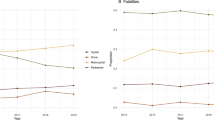Abstract
The risk of fire in parking buildings is dependant on the probability of a fire occurring and the severity of the fire. This paper reviews the research data available on vehicle fires and suggests the severity of such a fire for a risk analysis. The paper then examines the historical data for vehicle fires in New Zealand parking buildings from 1995 to 2003 to determine the probability of the occurrence of such fires and the likelihood of multiple vehicle involvement. It is found that annual vehicle fire frequencies in parking buildings are generally lower than those in buildings of other occupancies but increases with the annual usage ratio.







Similar content being viewed by others
References
J.M. Watts and J.R. Hall, “Introduction to Fire Risk Analysis. Section 5 / Chapter 1,” in SFPE Handbook of Fire Protection Engineering, 3rd Ed., P.J. DiNenno (ed.), NFPA, Quincy, MA, 2002.
Y. Li, “Assessment of Vehicle Fires in New Zealand Parking Buildings,” MEFE Thesis. University of Canterbury, Christchurch, New Zealand, 2004.
New Zealand Building Industry Authority and Standards Association of New Zealand. Approved Document for New Zealand Building Code: Fire Safety Clauses. Standards New Zealand, Wellington, New Zealand, 2000.
National Fire Protection Association. NFPA 88A, Standard for Parking Structures. National Fire Protection Association, Quincy, MA, 1998.
H. Ingason, “An Overview of Vehicle Fires in Tunnels,” SP Swedish National Testing and Research Institute, Boras, Sweden, 2001.
M. Shipp, “Vehicle Fires and Fire Safety in Tunnels,” Tunnel Management International, vol. 5, no. 3, 2002.
National Fire Protection Association. NFPA 204, Guide for Smoke and Heat Venting. National Fire Protection Association, Quincy, MA, 1998.
J. Mangs and O. Keski-Rahkonen, “Characterisation of the Fire Behaviour of a Burning Passenger Car. Part I: Car fire experiments,” Fire Safety Journal, vol. 23, 1994, pp. 17–35.
J.B. Schleich, L.G. Cajot, M. Pierre, and M. Brasseur, “Development of Design Rules for Steel Structures Subjected to Natural Fires in Closed Car Parks,” European Commission, Luxembourg, 1999.
C. Steinert, “Experimental Investigation of Burning and Fire Jumping Behavior of Automobiles,” VFDB Journal, vol. 4, 2000, pp. 163–172.
M.P. Shipp, and M.J. Spearpoint, “Measurements of the Severity of Fires Involving Private Motor Vehicles,” Fire and Materials, vol. 19, 1995, pp. 143–151.
D.W. Stroup, L. DeLauter, J. Lee, and G. Roadarmel, “Passenger Minivan Fire Tests,” National Institute of Standards and Technology, Gaithersburg, MD, USA, 2001.
J. Santrock, “Project B.14 - Demonstration of Enhanced Fire Safety Technology—Fire Retardant Materials—Part 1: Full Scale Vehicle Fire Tests of a Control Vehicle and a Test Vehicle Containing an HVAC Module,” General Motors Corporation, Warren, MI, USA, 2002.
V. Babrauskas, “Heat Release Rates,” Section 3 / Chapter 1, in SFPE Handbook of Fire Protection Engineering, 3rd Ed., P.J. DiNenno (ed.), NFPA, Quincy, MA, 2002.
BHP. Fire and Unprotected Steel in Closed Carparks. BHP Melbourne Research Laboratories, Melbourne, 1987.
T. Kitano, O. Sugawa, H. Masuda, T. Ave, and H. Uesugi, “Large Scale Fire Tests of 4-Story Type Car Park Part 1: The Behavior of Structural Frame Exposed to the Fire at the Deepest Part of the First Floor,” in 4th Asia-Oceania Symposium on Fire Science and Technology, Tokyo, Japan, May 24–26, 2000, pp. 527–538.
New Zealand Fire Service. New Zealand Fire Service Fire Incident Reporting System Instruction & Coding Manual: For Data Collected After 1 July 1995. Planning and Review Division National Headquarters, Wellington, NZ, 1995.
D. Denda, “What About Parking Garage Fires,” American Fire Journal, vol. 45, no. 2, 1993, pp. 22–25, 27.
L.M. Harris, “Survey of Fire Experience in Automobile Parking Structures in the United States and Canada,” Marketing Research Associates, Teaneck, NJ, 1972.
D. Joyeux, Statistics in Car Parks. Report INC-01/91 – DJ. CTICM – Department Incendie et Essais. Saint-Remy-Les-Chevreuse, France, 2001.
E. Whitaker, “Vehicle Fires—Looking Behind the Statistics,” Fire Prevention, vol, 222, 1989, pp. 33–38.
M. Ahrens, “U.S. Vehicle Fire Trends and Patterns,” National Fire Protection Association, Quincy, MA, 2001.
Federal Emergency Management Agency. “Highway Vehicle Fires,” Topical Fire Research Series, vol. 2, no. 4, 2001, pp. 1–2.
A. Tipping, “What Happens to a Car When it Reaches the End of its Life?—Environmental Effects of Car Disposal,” Statistics New Zealand, Wellington, 1998.
G. Moore, “Vehicle Fires in the United Kingdom—Or ‘Tombstone Technology’,” Fire International, vol. 137, 1992, pp. 22–23.
Department for Transport, Age of household cars, 1992–1994 and 1999–2001: Regional Trends 38, National Travel Survey, Last updated: 25/2/04, Available online http://www.statistics.gov.uk, Accessed June 2004.
E.M. Trisko, “Results of the 1973 National Survey of Motor Vehicles Fires,” Fire Journal, vol. 69, 1975, pp. 19–27.
S.E. Chandler and M.P. Shipp, “Channel Tunnel–A Statistical Study of the Fire Incidence in Road Vehicles,” Fire Safety Engineering, vol. 2, no. 3, 1995, pp. 10–12.
Christchurch City Council, Parking Strategy for the Garden City. Christchurch City Council, Christchurch, New Zealand, Available online http://www.ccc.govt.nz/parkingstrategy/parkingstrategy.pdf, 2003. Accessed February 2004.
A.P. Chrest, M.S. Smith, S. Bhuyan, M. Iqbal, and D.R. Monahan, Parking Structures: Planning, Design, Construction, Maintenance, and Repair, 3rd Ed., Chapman & Hall, New York, 2000.
G. Ramachandran, “Probabilistic Approach to Fire Risk Evaluation,” Fire Technology, vol. 24, no. 3, 1988, pp. 204–226.
D.J. Rasbash, D. Ramachandran, B. Kandola, J.M. Watts, and M. Law, Evaluation of Fire Safety, John Wiley & Sons, Ltd, 2004.
New Zealand Fire Service. Emergency Incident Statistics 1 July 2002–30 June 2003, National Headquarters, Wellington, NZ, 2003.
Acknowledgments
The authors would like to thank Neil Challands of the New Zealand Fire Service for assistance with the FIRS database. The University of Canterbury Fire Engineering programme is supported by the New Zealand Fire Service Commission.
Author information
Authors and Affiliations
Corresponding author
Rights and permissions
About this article
Cite this article
Li, Y., Spearpoint, M. Analysis of Vehicle Fire Statistics in New Zealand Parking Buildings. Fire Technol 43, 93–106 (2007). https://doi.org/10.1007/s10694-006-0004-2
Received:
Accepted:
Published:
Issue Date:
DOI: https://doi.org/10.1007/s10694-006-0004-2




